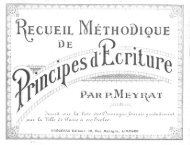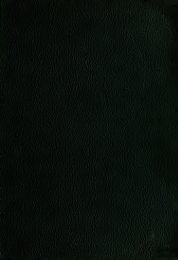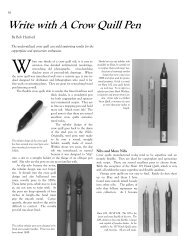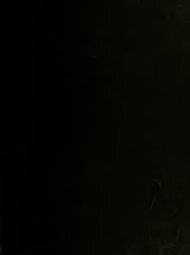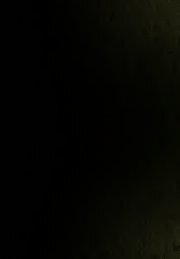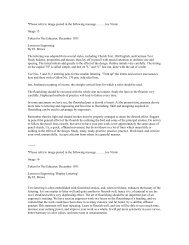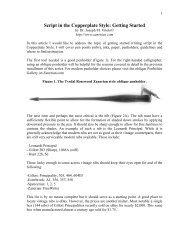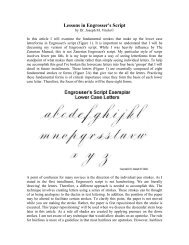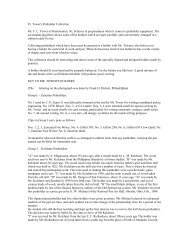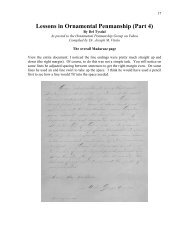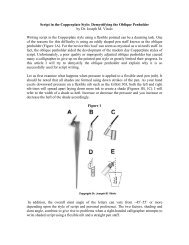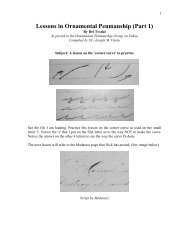The Educator (Volume 45) - IAMPETH
The Educator (Volume 45) - IAMPETH
The Educator (Volume 45) - IAMPETH
Create successful ePaper yourself
Turn your PDF publications into a flip-book with our unique Google optimized e-Paper software.
At Forest Park School, Fort<br />
" Wayne, Indiana, the left-handed children<br />
are receiving very fine instractions.<br />
<strong>The</strong> accompanying photograph<br />
shows a left-handed club in the Forest<br />
Park School, which meets every<br />
Monday afternoon to practice writing<br />
and to work out their left-handed<br />
problems together. <strong>The</strong>se pupils have<br />
mutual problems and understandings.<br />
<strong>The</strong>ir get-together is not only beneficial<br />
from a standpoint of handwriting,<br />
but also from a social standpoint,<br />
and we predict that some of<br />
the friendships formed in this club<br />
will be very lasting.;<br />
Left-handedness is the exception<br />
rather than the rule and it is the<br />
duty of teachers to try to find out<br />
the "whys" and "wherefores" of the<br />
left-handed children.<br />
<strong>The</strong> first thing which teachers<br />
should do is to determine if the child<br />
is really left-handed. If he is lefthanded<br />
he will, more than likely, do<br />
many things such as play ball, comb<br />
his hair, etc., with his left hand. Mrs.<br />
Smith believes that this type of children<br />
should be encouraged to write<br />
well with their left hands with their<br />
papers properly placed and the pens<br />
pointing over the left shoulders.<br />
If a child does everything but write<br />
with his right hand, it is possible<br />
that he could secure better results<br />
with his right hand. Some teachers<br />
encourage children to change over if<br />
possible, when they first start to<br />
school. It is not well to force children<br />
to make the change. Teachers<br />
today are hesitant in making changes.<br />
<strong>The</strong>re is a possibility that an injury<br />
may be sustained by children forced<br />
to change. We as right-handed people<br />
do not know just how much shock<br />
can be caused.<br />
Dr. Prank N. Freeman, in Correlated<br />
Teachers' Manual No. 1, sums<br />
it up in the following words: "Some<br />
scientists believe they have evidence<br />
which proves that to force a really<br />
left-handed person to write with his<br />
right hand is injurious to his nervous<br />
system and may cause speech difficulty.<br />
<strong>The</strong> safest practice is to try<br />
gently to induce the child who uses<br />
his left hand to use his right—first<br />
at the blackboard and then at the<br />
seat. If he yields to persuasion without<br />
difficulty it may be assumed that<br />
he is not strongly left-handed. If he<br />
resists strongly or comes back again<br />
and again to his left hand it is better<br />
to allow him to use it.<br />
"A great deal of the difficulty in<br />
left-handed writing is due to the fact<br />
that the child is not taught to take<br />
the position suited to the left hand.<br />
He places the paper in the position<br />
for right-handed writing and then<br />
twists his hand over above the v^riting<br />
or shoves the pen along. He<br />
should, of course, place his paper in<br />
the reverse position from that required<br />
in right-handed writing.<br />
"If a child in the intemiediate or<br />
upper grades writes fairly well %vith<br />
his left hand, in the proper position,<br />
he should not be disturbed. If he<br />
writes in the incorrect position an<br />
<strong>The</strong> <strong>Educator</strong><br />
attempt should be made to induce him<br />
either to use his right hand or to<br />
adopt the correct position with his<br />
left hand."<br />
<strong>The</strong>re was a time when teachers<br />
tried to change all left-handed students<br />
to write right-handed. This<br />
was a failure in many instances, especially<br />
where the student was decidedly<br />
left-handed. In some cases<br />
students did learn to write with the<br />
right hand in the writing class and<br />
used the left hand out of school.<br />
Teachers today realize that one can<br />
be a good writer by using either the<br />
right or the left hand. <strong>The</strong>y also<br />
realize that the change from one<br />
hand to the other requires a lot of<br />
effort on the part of the students.<br />
After determining that a child is<br />
left-handed one of the first things<br />
naturally to do is to get correct position.<br />
<strong>The</strong> second important thing<br />
is to encourage and to instill confidence.<br />
<strong>The</strong> third thing is to teach<br />
the forms of the letters and movement<br />
in the same earnest manner in<br />
which you teach right-handed students.<br />
Give attention to position at the board.<br />
17<br />
This second-grade girl is showing<br />
the proper position for the left-handed<br />
student. <strong>The</strong> top of the paper is<br />
tilted towards the right, just the<br />
opposite of that of the right-handed<br />
student.



